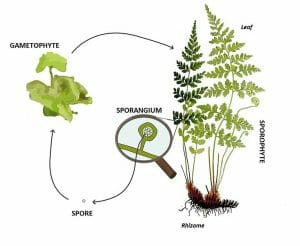Diploid Definition
Diploid describes a cell or nucleus which contains two copies of genetic material, or a complete set of chromosomes, paired with their homologs (chromosome carrying the same information from the other parent). By maintaining two copies of the genetic code, diploid organisms obtain an advantage by having greater genetic variation within their population, as each individual can express two alleles for each gene. Other organisms cycle between diploid and haploid lifecycles.
Examples of Diploid
Forming a Zygote
In mammals, a diploid zygote is created when two haploid gametes meet and form a single cell. This process adds the haploid DNA from each gamete into a combined diploid genome of the new zygote. Many animals reproduce using this method, although not all. The haploid stage of most animals is restricted to the single-celled gametes used for reproduction. The rest of the lifecycle is spent as a diploid, multi-celled organism.
Lifecycle of a Fern
Unlike humans and other mammals, ferns have an entire multi-celled stage of their lifecycle which is not diploid. Look at the diagram below. During the sporophyte phase, the plant is diploid. This diploid plant creates spores through meiosis, which are now haploid. The haploid cells are released into the air and travel to a new area.
Once established, the haploid spore grows into a gametophyte. The gametophyte is an entire haploid organism, separate from the first plant. This small plant has special tissues which create gametes in the form of sperm and eggs. These haploid cells find each other and fertilize one another, creating diploid zygotes. These zygotes then grow into full sporophytes, and the cycle starts over. Where humans and many familiar animals spend the entirety of their lives as diploid organisms, many species such as ferns and insects are not that way.
Quiz
1. Human gametes contain 23 chromosomes. How many individual chromosomes are present in a diploid zygote?
A. 23
B. 46
C. 40
References
- Hartwell, L. H., Hood, L., Goldberg, M. L., Reynolds, A. E., & Silver, L. M. (2011). Genetics: From Genes to Genomes. Boston: McGraw Hill.
- McMahon, M. J., Kofranek, A. M., & Rubatzky, V. E. (2011). Plant Science: Growth, Development, and Utilization of Cultivated Plants (5th ed.). Boston: Prentince Hall.

